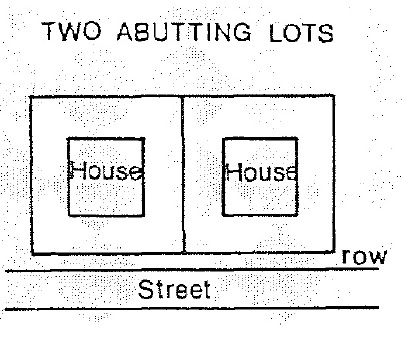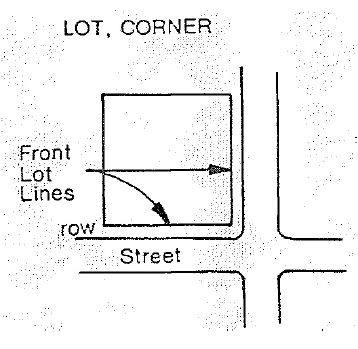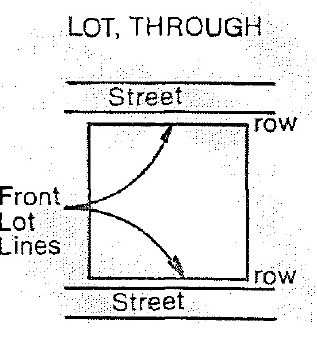For the purpose of this chapter, the following definitions shall apply unless the context clearly indicates or requires a different meaning.
ABUTTING. As applied to lots, means having a common line or district line, or so located in relation to each other that there would be a common lot line or district line but for the existence of a street, alley or other public right-of-way.

ACCESS WAY. A curb cut, ramp, driveway or other means for providing vehicular access to an off-street parking or loading area.
ACCESSORY USE. Any structure or use that is:
(1) Subordinate in size or purpose to the principal structure or use which it serves;
(2) Necessary or contributing to the comfort and convenience of the occupants of the principal structure or use served; and
(3) Located on the same lot as the principal structure or use served.
ADMINISTRATOR. The person or organization assigned to administer the ordinance by the City Council.
AGRICULTURE. Any one or any combination of the following: the growing of farm or truck garden crops, dairying, pasturage, horticulture, floriculture or animal/poultry husbandry. The term AGRICULTURE encompasses the farmhouse, and accessory uses and structures customarily incidental to agricultural activities.
AISLE. A vehicular traffic way within an off-street parking area, used as a means of access/egress from parking spaces.
ALLEY. A public right-of-way which affords a secondary means of vehicular access to abutting premises that front on a nearby street.
ALTER. To change the size, shape or use of a structure.
AMENDMENT. A change in the provisions of this chapter (including those portions incorporated by reference), properly affected in accordance with state law and the procedures set forth herein.
APARTMENT. See DWELLING, MULTIPLE-FAMILY.
ATTACHED. As applied to buildings, means having a common wall and/or common roof.
BLOCK. An area of land entirely bounded by streets, highways, barriers or ways (except alleys, pedestrian ways or exterior boundaries of a subdivision unless exterior boundary is a street, highway or way), or bounded by a combination of streets, public parks, cemeteries, railroad rights-of-way, waterways or corporate boundary lines.
BOARD OF APPEALS. The Board of Zoning Appeals of Vienna, Illinois.
BUILDING. Any covered structure permanently affixed to land and designed or used to shelter persons or chattels.
BUILDING HEIGHT.
(1) The vertical distance measured from the average grade at the front wall of a building to the highest point of the coping of flat roof or to the deck line of mansard roof, or to the mean height level between eaves and ridge for gable, hip or gambrel roofs.
(2) Chimneys, towers, cooling towers and similar projections shall not be included in calculating
BUILDING HEIGHT.
BUILDING LINE. The line nearest the front of and across a lot, delineating the minimum open space required between the front of a structure and the street right-of-way line.
CITY. The City of Vienna, Illinois.
CLINIC. An establishment where licensed physicians or dentists practice medicine or dentistry, but where overnight lodging for sick or injured persons is not provided.
CLUB/LODGE. A nonprofit association of persons who are bonafide members organized for some purpose(s) and paying regular dues and whose facilities are restricted to members and their guests; not including a group organized solely or primarily to render a service customarily carried on as a commercial enterprise.
CONFORMING. In compliance with the applicable provisions of this chapter.
DAY CARE CENTER. See NURSERY SCHOOL.
DETACHED. As applied to buildings, means surrounded by yards on the same lot as the building.
DEVELOP. To erect any structure or to install any improvements on a tract of land, or to undertake any activity (such as grading) in preparation therefore.
DIMENSIONS. Refers to both lot depth and lot width.
DISTRICT, ZONING. A portion of the territory subject to this chapter wherein certain uniform requirements or various combinations thereof apply to structures, lots and uses under the terms of this chapter.
DRIVEWAY. A minor way commonly providing vehicular access to a garage or off-street parking area.
DWELLING. A building or portion thereof designed or used primarily as living quarters for one or more families, but not including hospitals, nursing homes, hotels, motels or other accommodations for the transient public.
DWELLING, MULTIPLE-FAMILY. A building or portion thereof containing two or more dwelling units.
DWELLING, SINGLE-FAMILY. A dwelling containing one dwelling unit and intended for the occupancy of one family.
DWELLING UNIT. One or more rooms designed or used as living quarters by one family. A DWELLING UNIT always includes a bathroom and a kitchen.
EASEMENT. A right to use another person’s real property for certain limited purposes.
ENCLOSED. As applied to a building, means covered by a permanent roof and separated on all sides from adjacent open space or other buildings by fixed exterior walls or by common walls, with openings only for windows and doors.
ENLARGE. To increase the size (floor area, height and the like) of an existing principal structure or accessory use, or to devote more land to an existing use.
ERECT. To build, construct.
ESTABLISHMENT. Either of the following:
(1) An institutional, business, commercial or industrial activity that is the sole occupant of one or more buildings; or
(2) An institutional, business, commercial or industrial activity that occupies a portion of a building such that:
(a) The activity is a logical and separate entity from the other activities within the building and not a department of the whole; and
(b) The activity has either a separate entrance from the exterior of the building, or a separate entrance from a common and clearly defined entryway that has direct access to the exterior of the building.
EXISTING. Actually constructed or in operation on the effective date of this chapter.
FAMILY. One person, or two or more persons related by blood, marriage or legal adoption, or not more than three unrelated persons, maintaining a common household in a dwelling unit.
FLOOR AREA, GROSS. The sum of the gross horizontal areas of the several floors of a building, measured from the exterior faces of the exterior walls or from the center of the common walls of attached buildings. GROSS FLOOR AREA includes basement floors; attic floor space; halls, closets, stairwells; space devoted to mechanical equipment; and enclosed porches.
FRONTAGE. The linear extent of the front (street-side) of a lot.
GREENHOUSE. See NURSERY.
HEREAFTER. Any time after the effective date of this chapter.
HOME OCCUPATION. Any business, profession or occupation conducted for gain entirely within a dwelling or on residential premises in conformity with the provisions of this chapter.
HOSPITAL. An institution devoted, on an around-the-clock basis, to the maintenance and operation of facilities for the diagnosis, treatment or care of members of the general public suffering from disease, injury or other abnormal physical conditions. The term HOSPITAL as used in this chapter includes sanitariums, but excludes institutions operating solely for the treatment of insane persons, drug addicts or alcoholics, and convalescent/nursing homes.
IMMOBILIZE. As applied to a mobile home, means to remove the wheels, tongue and hitch and/or to place on a permanent foundation.
INTERSECTION. The point at which two or more public rights-of way (generally streets) meet.
KENNEL. Any structure or premises at which dogs, cats or other household domestic animals are kept on a regular basis for the purpose of sale, adoption, breeding or training, and for which a fee is charged.
LOADING SPACE. An off-street space used for the temporary parking of a commercial vehicle while loading or unloading merchandise or materials.
LOT. A tract of land intended as a unit for the purpose (whether immediate or future) of transfer of ownership or development. A LOT may or may not coincide with a “lot of record”.
LOT, CORNER. A lot having at least two adjacent sides that abut for their full length upon street rights-of-way, but no alleys or other minor ways. Both such lines shall be deemed front lot lines.

LOT, THROUGH. A lot having a pair of approximately parallel lot lines that abut two approximately parallel street rights-of-way. Both lot lines shall be deemed front lot lines.

LOT AREA. The area of a horizontal plane bounded by the front, side and rear lines of a lot.
LOT COVERAGE. The portion of a lot that is occupied by buildings or structures, including accessory buildings or structures.
LOT DEPTH. The average horizontal distance between the front lot line and the rear lot line of the lot.
LOT LINE, FRONT. The lot boundary abutting the street right-of-way.
LOT LINE, REAR. An interior lot line which is most distant from and most nearly parallel to the front lot line.
LOT LINE, SIDE. Any boundary of a lot which is not a front lot line or a rear lot line.

LOT SIZE REQUIREMENTS. Refers to the lot area, width and depth requirements of the applicable district.
LOT WIDTH. The average horizontal width of a lot measured at right angles to the side lot lines.
MAINTENANCE. The routine upkeep of a structure, premises or equipment, including the replacement or modification of structural components to the extent necessary to keep the said structure in sound condition.
MOBILE HOME. A manufactured structure originally designed to permit its transport on wheels, for occupancy and use as a dwelling by persons, whether or not it is actually so occupied or used at a given time or location.
MOBILE HOME PARK. A lot(s) not less than two acres in area in single ownership/control, developed with facilities for accommodating occupied mobile homes in accordance with the requirements of the city’s mobile home regulations.
MOBILE HOME STANDARDS. The part of the mobile home space beneath a mobile home that includes a concrete slab or runners on which the home is placed.
NONCONFORMING. As applied to a lot, structure or use, means lawfully existing on the effective date of this chapter, but not in compliance with applicable provisions thereof.
NUISANCE. Any thing, condition or conduct that endangers health, or unreasonably offends the senses, or obstructs the free use and comfortable enjoyment of property, or essentially interferes with the comfortable enjoyment of life.
NURSERY. A tract of land on which trees, shrubs and other plants are raised for transplanting and sale, and including any structure in which said activities are conducted.
NURSERY SCHOOL. An establishment for the part-time care and/or instruction at any time of day of four or more unrelated children of pre-elementary school age.
NURSING HOME. A building used as medical care facility for persons who need long term nursing care and medical services, but do not require intensive hospital care.
OFFICE. Any building or portion thereof in which the business (usually clerical and administrative affairs) of a commercial/service enterprise or professional person is transacted.
PARKING AREA/LOT, OFF-STREET. Land that is improved in accordance with this chapter and used primarily for the storage of passenger motor vehicles, free of charge or for compensation. An OFF-STREET PARKING AREA, depending on the circumstances of its use, is either a principal use or an accessory use.
PARKING SPACE, OFF-STREET. An area at least 20 feet long and ten feet wide within an off-street parking area or garage, used for the storage of one passenger motor vehicle.
PERMITTED USE. Any use which is or may be lawfully established in a particular district, provided it conforms with all the requirements applicable to said district.
PERSON. Any individual, firm, association, organization or corporate body.
PET BOARDING FACILITY. An animal facility used for the care and temporary boarding (including daycare) of dogs and cats and household domestic animals in return for consideration, not including an animal hospital which only boards animals receiving medical treatment.
PLOT. A parcel of land consisting of one or more lots or portions thereof which is described by reference to a recorded plat or by metes and bounds.
PREMISES. A lot and all the structures and uses thereon.
PRINCIPAL BUILDING/STRUCTURE/USE. The main structure erected on or the main use occupying a lot, as distinguished from an accessory (subordinate) structure or use.
PROPERTY LINE. See LOT LINE.
RECONSTRUCT. As applied to nonconforming structures, means to rebuild after partial or total destruction.
RELOCATE. To move to another portion of a lot or to a different lot.
REPAIR. To restore to sound condition, but not to reconstruct.
RETAIL. Refers to the sale of goods or services directly to the consumer rather than to another business.
RIGHT-OF-WAY, PUBLIC. A strip of land which the owner/subdivider has dedicated to the city or to another unit or government for streets and alleys.
SERVICE USE/ESTABLISHMENT. Any use or establishment wherein services are provided for remuneration either to individuals or to other firms.
SETBACK. The distance between the front lot line and the building line, or between a side or rear lot line and that side of the structure which faces such lot line, or between the appropriate lot line and the nearest boundary of the area of operation which is approximately parallel to such lot line.
SINGLE-FAMILY RESIDENCE. See DWELLING, SINGLE-FAMILY.
SKIRTING. The covering affixed to the bottom of the exterior walls of a mobile home to conceal the underside thereof.
SPECIAL USE. A use that has unusual operational, physical or other characteristics which distinguish it from the permitted uses of a district, but which can be made compatible with the intended overall development within a district. SPECIAL USES commonly must meet special standards not necessarily applicable to permitted uses in the district, and are allowed only by permit.
SPECIAL USE PERMIT. A permit issued in accordance with the provisions of this chapter to regulate the development/operation of a special use.
STABLE. A structure, situated on the same lot as a dwelling, and designed or used for housing horses for the private use of occupants of the dwelling, but not for hire.
STREET.
(1) A public or private way for motor vehicle travel.
(2) The term
STREET includes a highway, thoroughfare, parkway, throughway, road, pike, avenue, boulevard, lane, place, drive, court and similar designations, but excludes an alley or a way for pedestrian use only.
STREET, PRIVATE. Any street providing access to abutting property that is not maintained by and dedicated to the city or other public entity.
STRUCTURE.
(1) Anything constructed or erected on the ground, or attached to something having a fixed location on the ground.
(2) All buildings are
STRUCTURES, but not all STRUCTURES are buildings.
STRUCTURE, TEMPORARY. Any structure that is not attached to a permanent foundation.
TEMPORARY USE PERMIT. A permit issued in accordance with the provisions of this chapter and valid for not more than one year, which allows the erection or occupation of a temporary structure or the operation of a temporary enterprise.
TOPOGRAPHY. The physical relief features or surface configuration of an area.
USE. The purpose or activity for which land or structure thereon is designed, occupied or used.
USE VARIANCE. A type of amendment (not variance) that allows a use in a district where said use would not be allowed under existing provisions of this chapter.
UTILITY SUBSTATION. A secondary utility facility such as an electrical substation, gas regulator station, telephone exchange facility, sewage treatment plant and the like.
VARIANCE. A relaxation of the strict application of the lot size, setbacks or other bulk requirements applicable to a particular lot or structure.
WHOLESALE. Refers to the sale of goods or services by one business to another business.
YARD. Open space that is unobstructed except as specifically permitted in this chapter and this is located on the same lot as the principal building.
YARD, FRONT. A yard which is bounded by the side lot lines, front lot lines and the building line.
YARD, REAR. A yard which is bounded by side lot lines, rear lot lines and the rear yard line.
YARD, SIDE. A yard which is bounded by the rear yard line, front yard line, side yard line and side lot line.
YARD LINE. A line in a lot that is parallel to the lot line along which the yard in question extends and which is not nearer to such lot line at any point than the required depth or width of said yard.
ZONING MAP. The map and any amendments thereto designating zoning districts, and incorporated into this chapter by reference.
(1975 Code, § 32-II.2) (Ord. 2001-02, passed 2-7-2001; Ord. 16-01, passed 4-6-2016)